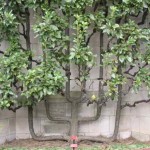by Catherine Haug, April 18, 2012
(photo fromWikipedia)
Espalier, though originally developed by the Romans for fruit trees, was perfected in France; hence it’s French name (pronounced es-PAL-yay). From Better Homes & Gardens, “An espalier is a living fence created by training small trees into decorative patterns.”
There’s lots to like in a fruit tree espalier:
What’s to like about espalier
While the following is mainly about fruit trees, many of the items can apply to any living fence (flowering shrubs, evergreens, etc.):
- Provides a good-neighbor fence, with treats for both sides;
- Keeps the fruit within picking distance without a ladder (expect to wait 3 years for fruit); and
- Has the potential for a higher yield in a smaller area than a standard orchard by directing energy away from vigorous vertical growth and into producing spurs;
- For those who have a small garden but big ambitions, you can grow fruit without having one or two trees dominate the entire area;
- Adds beauty to your yard through the fence design;
- Creates a favorable microclimate by radiating heat and providing shelter;
- Can be used to border a meditation or private area in your yard;
- Can block view of your compost bin, or of a neighbor’s cluttered yard.
What’s required?
The most important thing is to use dwarf varieties of fruit trees, such as apple, pear, plums or grapes. Or for variety, you can use flowering shrubs, climbing or vining plants. Three or more will make a good fence.
You can espalier to a wall (although a south-facing wall that gets no relief from the sun, is not a good choice), to a wood fence or lattice work, or a wire fence suspended between attractive wood posts. Use plant ties to secure to a wire fence or support. Use eye-screws to attach branches to wood, brick, masonry or stucco; however, for surfaces other than wood, you need to pre-drill the hole and insert a plastic expansion anchor before threading the eye-screw into the anchor.
If using 2- to 3- year old dwarf fruit trees, plant them at least an arm’s length apart. If you plan to train to a wall, plant at least a foot away from the wall.
The best time to prune and train is in late winter (when you would normally prune a fruit tree – early to mid March in our area). Remove fruit buds the first two years to concentrate the tree’s energy into growing branches; look for fruit in the third year.
See references below, for lots more info including instructions and inspiration.
References:
General
- Mother Earth News: Espalier Trees
- Garden Ideas: Grow a Living Fence
How To
- Better Homes and Gardens: How to build a living fence
- eHow: Build a Tree Espalier; How to Train Espaliers; Pruning Espalier Apple Trees; Plant Fruit Trees Close & Prune For an Espalier; Espalier Grapes; Espalier Plum Trees
- Deep Green Permaculture: Espalier Support/Trellis: What is an Espalier (and how-to) and Grape Vine Trellis
How-To Videos
- eHow video: How to Espalier a Tree
- DIY video: Instant Espalier Fence
Design
- Wikipedia: Espalier Fruit Tree Forms
- River Road Farms Espalier patterns
- Espalier Services: Photos of different espalier designs, ideas; Espalier patterns

Small gardens are quite cute and i always use them in our home and appartment. Despite their small size, they are quite nice to the eyes and gives you a relaxing atmosphere. *,*,:
Best regards